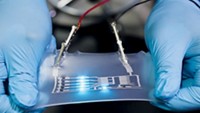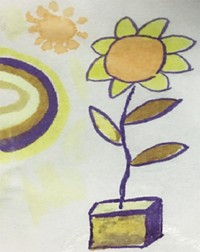Advertisement
Grab your lab coat. Let's get started
Welcome!
Welcome!
Create an account below to get 6 C&EN articles per month, receive newsletters and more - all free.
It seems this is your first time logging in online. Please enter the following information to continue.
As an ACS member you automatically get access to this site. All we need is few more details to create your reading experience.
Not you? Sign in with a different account.
Not you? Sign in with a different account.
ERROR 1
ERROR 1
ERROR 2
ERROR 2
ERROR 2
ERROR 2
ERROR 2
Password and Confirm password must match.
If you have an ACS member number, please enter it here so we can link this account to your membership. (optional)
ERROR 2
ACS values your privacy. By submitting your information, you are gaining access to C&EN and subscribing to our weekly newsletter. We use the information you provide to make your reading experience better, and we will never sell your data to third party members.
Coatings
A hot take on rewritable paper
Thermochromic paper can be written on with heat and erased by cooling
by Melissa Pandika, special to C&EN
January 3, 2019

Paper often faces a short useful life, with printed products ending up in the trash or recycling bin soon after they’re read. Researchers have worked to reduce this waste by making paper that can be written on and cleared several times over. A new approach uses relatively simple chemistry to make rewritable paper that can be written on with mild heat and erased by freezing (ACS Appl. Mater. Interfaces 2018, DOI: 10.1021/acsami.8b14625).
Many approaches to developing rewritable paper have emerged over the past 15 years, but they have their limitations. Some use complicated, time-consuming fabrication methods. Others need ultraviolet light or chemical reagents to erase the printed content, or a continuous power supply for the printing to remain visible. A team led by Luzhuo Chen of Fujian Normal University set out to devise a more practical, easier-to-produce solution—paper that allows people to repeatedly write and erase content just by raising or lowering the temperature.
To fabricate their paper, the researchers first screen-printed one side of a sheet of paper with a thermochromic dye mixture that changes color with changes in temperature—specifically, it changes from blue to colorless when heated. They then laser printed the other side of the paper with black toner that gives off heat when excited by infrared light.
The thermochromic mixture contains three components—including crystal violet lactone (CVL), a color developer, and a solvent—found in ink used in erasable pens. Below a certain low threshold temperature, the electron-accepting color developer and the CVL form a complex and crystallize, opening the lactone ring on CVL to create a blue color. But above a higher color-changing temperature, the CVL and the color developer dissolve in the solvent, separating from each other, which allows the lactone ring to close, turning the compound colorless. In addition, the dissolution of the two components turns the solvent liquid, so the compound stays colorless even when cooled. Cooling the dye back down to below the threshold temperature recrystallizes the two components into the solid state, which allows them to interact again and opens the lactone ring, restoring the mixture’s blue color.
Chen and colleagues determined the exact threshold temperatures for writing and erasing—that is, the temperatures that make the blue thermochromic dye mixture colorless and return it to blue. They gradually heated the paper from room temperature, or 20 °C, to 80 °C on a hot plate and then cooled it to below 20 °C in a freezer. Using absorption spectroscopy, they measured any resulting color changes.
Above 65 °C, the paper surface turned from blue to colorless and remained so during cooling. Only when the temperature dipped below -10 °C did the surface turn blue again, suggesting the paper can retain writing even at room temperature. The team saw the same color-change patterns even after repeating the heating and cooling process 100 times, evidence of the paper’s reusability.
Next, the researchers wrote on the paper with an electric pen that uses heat as “ink.” They also used a thermal printer to print text and images on the paper, and shone infrared light through a stencil to print images on transparent cell phone cases with the rewritable paper inside them. The text and images remained visible even after storing the printed materials on lab benches at room temperature for six months. As before, the paper became completely blue again in about five minutes below -10 °C.
Advertisement
Christopher Luettgen of the Georgia Institute of Technology says the composition of the coating the researchers used on their paper appears to be “new and unique,” resembling the coating used on glossy, magazine-grade paper.
But Luettgen doubts whether rewritable paper will actually cut back on paper waste, in part because he believes it has a high potential to cause problems with recycling. Mary Anne White of Dalhousie University also has concerns about the wastefulness of the fabrication method, which involves “printing the whole piece of paper blue on one side and black on the other,” she says. “You can imagine how much that requires in terms of compounds.” But these concerns aside, “the manufacturing process seems fairly simple and straightforward,” making it feasible to expand to commercial scales, Luettgen says.
Chen believes his group’s paper could have a variety of practical applications, such as in labels or sticky notes. But Luettgen doubts consumers would want their notes or drawings to disappear; he views rewritable paper as more suitable for a niche market, perhaps for use as a novelty toy.





Join the conversation
Contact the reporter
Submit a Letter to the Editor for publication
Engage with us on Twitter